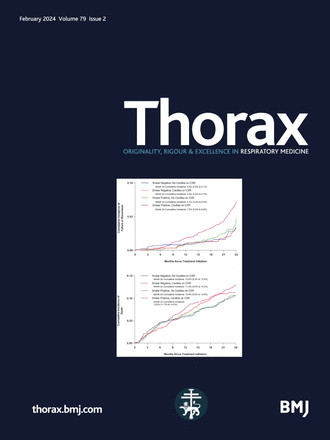空气污染与慢性阻塞性肺病患者的呼吸健康:我们应该关注室内还是室外污染源?
IF 9
1区 医学
Q1 RESPIRATORY SYSTEM
引用次数: 0
摘要
引言 虽然环境空气污染与慢性阻塞性肺病(COPD)患者呼吸系统健康之间的关系已被广泛研究,但人们对个人暴露于污染源的情况以及相关的健康影响却知之甚少。目的 将测得的个人总暴露量分为室内产生的污染和室外产生的污染,并在健康模型中使用这些改进的指标,以建立与病情加重和呼吸道症状更可靠的关联。方法 我们招募了 76 名慢性阻塞性肺病患者,使用便携式监测仪连续测量了他们的颗粒物和气态污染物个人暴露量以及位置,平均测量时间为 134 天。我们通过日记卡和呼气峰值流速(PEF)收集与呼吸道症状相关的日常健康信息。我们采用混合效应模型来量化个人接触的污染物总量、室内产生的污染物和室外产生的污染物与病情加重、症状发生和 PEF 之间的关系。结果 室内外二氧化氮暴露均与病情加重和呼吸道症状有关。我们观察到,总暴露量、室内产生的暴露量和室外产生的暴露量每增加 IQR,病情加重的几率分别增加 33%(22%-45%)、19%(12%-18%)和 12%(5%-20%)。一氧化碳对健康的影响主要归因于室内产生的污染。虽然没有观察到颗粒物2.5与慢性阻塞性肺病恶化有关,但室内产生的颗粒物与肺活量的显著下降有关。结论 室内和室外产生的污染会恶化慢性阻塞性肺病患者的健康。政策制定者、医生和慢性阻塞性肺病患者应注意减少接触这两种污染源的重要性,以降低病情恶化的风险。暂无数据。本手稿使用的数据集包含个人数据,不可共享。本文章由计算机程序翻译,如有差异,请以英文原文为准。
Air pollution and respiratory health in patients with COPD: should we focus on indoor or outdoor sources?
Introduction While associations between ambient air pollution and respiratory health in chronic obstructive pulmonary disease (COPD) patients are well studied, little is known about individuals’ personal exposure to pollution and associated health effects by source. Aim To separate measured total personal exposure into indoor-generated and outdoor-generated pollution and use these improved metrics in health models for establishing more reliable associations with exacerbations and respiratory symptoms. Methods We enrolled a panel of 76 patients with COPD and continuously measured their personal exposure to particles and gaseous pollutants and location with portable monitors for 134 days on average. We collected daily health information related to respiratory symptoms through diary cards and peak expiratory flow (PEF). Mixed-effects models were applied to quantify the relationship between total, indoor-generated and outdoor-generated personal exposures to pollutants with exacerbation and symptoms occurrence and PEF. Results Exposure to nitrogen dioxide from both indoor and outdoor sources was associated with exacerbations and respiratory symptoms. We observed an increase of 33% (22%–45%), 19% (12%–18%) and 12% (5%–20%) in the odds of exacerbation for an IQR increase in total, indoor-generated and outdoor-generated exposures. For carbon monoxide, health effects were mainly attributed to indoor-generated pollution. While no associations were observed for particulate matter2.5 with COPD exacerbations, indoor-generated particles were associated with a significant decrease in PEF. Conclusions Indoor-generated and outdoor-generated pollution can deteriorate COPD patients’ health. Policy-makers, physicians and patients with COPD should note the importance of decreasing exposure equally to both source types to decrease risk of exacerbation. No data are available. The datasets used for this manuscript contain personal data and cannot be shared.
求助全文
通过发布文献求助,成功后即可免费获取论文全文。
去求助
来源期刊

Thorax
医学-呼吸系统
CiteScore
16.10
自引率
2.00%
发文量
197
审稿时长
1 months
期刊介绍:
Thorax stands as one of the premier respiratory medicine journals globally, featuring clinical and experimental research articles spanning respiratory medicine, pediatrics, immunology, pharmacology, pathology, and surgery. The journal's mission is to publish noteworthy advancements in scientific understanding that are poised to influence clinical practice significantly. This encompasses articles delving into basic and translational mechanisms applicable to clinical material, covering areas such as cell and molecular biology, genetics, epidemiology, and immunology.
 求助内容:
求助内容: 应助结果提醒方式:
应助结果提醒方式:


